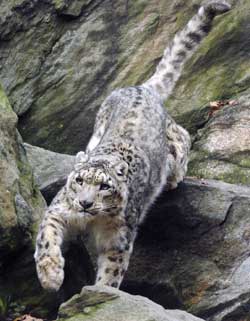Afghanistan Releases Its First-Ever List of Protected Species

Snow leopards are among the newly protected species in Afghanistan.
The wide-ranging list of endangered and threatened species includes such well known wildlife as snow leopards, wolves, and brown bears, but also lesser-known species such as the paghman salamander, goitered gazelle, and Himalayan elm tree.
The list, consisting of 20 mammals, seven birds, four plants, and a single amphibian and insect, provides legal protection to Afghanistan’s wildlife, which have been devastated by more than 30 years of conflict.
NEPA, in partnership with the USAID-funded* Wildlife Conservation Society, the Ministry of Agriculture, Irrigation and Livestock, and Kabul University created the Afghanistan Wildlife Executive Committee (AWEC) to facilitate the listing process. In July 2008, AWEC began evaluations of species such as the snow leopard, Marco Polo sheep, and Asiatic black bear. To make status determinations, AWEC and WCS worked with world-experts to obtain the most recent and accurate information available for Afghanistan and the region, and then evaluated those data using scientific criteria established by the global authority on species listing – the IUCN Red List. By the end of 2009, WCS says the list may be expanded to as many as 70 species.
“The Wildlife Conservation Society commends the Afghanistan’s National Environment Protection Agency for showing a continued commitment to conserving its natural heritage – even during these challenging times,” said Dr. Steven E. Sanderson, President and CEO of WCS. “WCS believes that conservation can often serve as diplomacy, and we are optimistic that this commitment to conservation will benefit all of Afghanistan’s people.”
In Afghanistan, species like the snow leopard are under pressure from excessive hunting, loss of key habitat and illegal trade. Snow leopard pelts for sale in tourist shops can go for as much as $1,500 each. International trade in species like the snow leopard is illegal under international law because it is globally endangered. Now that the snow leopard is protected under Afghan law, it is also illegal for Afghan nationals or internationals to hunt or trade the species within Afghanistan.
The protected species list also comes at a critical time for Afghanistan’s wild species. The Presidential Decree banning hunting in the country expired in March 2009. Only one week ago, it would have been legal for any person to kill an endangered species like the snow leopard in Afghanistan.
NEPA has also worked collaboratively with students at the University of Richmond in Virginia, USA to complete the listing process. In the spring semester of 2009, students conducted research on Afghan species for AWEC and participated electronically in an evaluation session to answer questions for the Committee. Six species assessed by students are now listed as protected in Afghanistan.
NEPA will be responsible for managing Afghanistan’s protected species including writing recovery plans for species designated as threatened. Species will be re-evaluated every five years to determine whether populations have recovered to the extent where they may be removed from the protected list.
NEPA gratefully acknowledges the assistance it has received from the international community including the USAID funded program of the Wildlife Conservation Society, and looks forward to its continued partnership with the Ministry of Agriculture, Irrigation, and Livestock and Kabul University in managing Afghanistan’s threatened and endangered species.
Last month, Afghanistan announced the creation of its first national park: Band-e-Amir, a spectacular series of six deep blue lakes separated by natural dams made of travertine, a mineral deposit.
WCS is currently the only organization conducting ongoing scientific conservation studies in Afghanistan in the past 30 years, and is continuing to work with the Afghan government to establish a network or parks and protected areas.
The Wildlife Conservation Society saves wildlife and wild places worldwide. We do so through science, global conservation, education and the management of the world's largest system of urban wildlife parks, led by the flagship Bronx Zoo. Together these activities change attitudes towards nature and help people imagine wildlife and humans living in harmony. WCS is committed to this mission because it is essential to the integrity of life on Earth. Visit: www.wcs.org
Special Note to the Media: If you would like to guide your readers or viewers to a web link where they can make donations in support of helping save wildlife and wild places, please direct them to: www.wcs.org/donation
*This program is made possible by the generous support of the American people through the United States Agency for International Development (USAID), under the terms of USAID/Afghanistan Leader with Associates Cooperative Agreement No. 306-A-00-06-00501-00. The contents of this press release are the responsibility of the Wildlife Conservation Society and do not necessarily reflect the views of USAID or the United States Government.
Media Contact
All latest news from the category: Ecology, The Environment and Conservation
This complex theme deals primarily with interactions between organisms and the environmental factors that impact them, but to a greater extent between individual inanimate environmental factors.
innovations-report offers informative reports and articles on topics such as climate protection, landscape conservation, ecological systems, wildlife and nature parks and ecosystem efficiency and balance.
Newest articles

Properties of new materials for microchips
… can now be measured well. Reseachers of Delft University of Technology demonstrated measuring performance properties of ultrathin silicon membranes. Making ever smaller and more powerful chips requires new ultrathin…

Floating solar’s potential
… to support sustainable development by addressing climate, water, and energy goals holistically. A new study published this week in Nature Energy raises the potential for floating solar photovoltaics (FPV)…

Skyrmions move at record speeds
… a step towards the computing of the future. An international research team led by scientists from the CNRS1 has discovered that the magnetic nanobubbles2 known as skyrmions can be…





















